Abstract
Historic buildings are an integral part of the built environment that have historical, cultural, social, and economic value. Sustainable conservation/rehabilitation/renovation of historic buildings that will perform well for decades is therefore critical. Numerous sustainability-rating systems (e.g., LEED, BREEAM, DGNB, etc.) have been developed to deal with broader sustainability objectives in the design of new buildings, which are not adequate/sufficient in intervention in historic buildings. This paper aims to study and explore rating systems for historic buildings. It is hypothesized that using rating systems can help historic buildings achieve more sustainable outcomes. The paper begins by presenting comprehensive background information on existing sustainability-rating systems worldwide, followed by a systematic review of the literature on rating systems for historic buildings. The PRISMA flowchart (Preferred Reporting Items for Systematic Reviews and Meta-Analyses) was used, searching Science Direct and Google Scholar databases. The study reveals most current studies focus on environmental aspects, such as improving the energy efficiency of historic buildings, which results in lowering economic costs and increasing occupant satisfaction with the indoor environment. We argue that all three traditional dimensions of sustainability should be balanced when developing or adapting the next generation of rating systems to assess/address the sustainability of historic buildings.
1. Introduction
Historic buildings are the cultural capital inherited from previous generations that must be passed on to future generations [1]. The Franceschini Commission (in 1967) refers to historic buildings as “material testimony of civilization”. They are an essential part of the cultural aspects of any country that has historical, cultural, artistic, social, and economic values [2]. Furthermore, historical buildings are the bearer of values that support the memory of human deeds and thoughts and are associated with the historical timeline [3]. The three main factors that determine which building should be registered as a cultural heritage are listed in [4], such as historical significance, historical integrity, and historical context.
Historical buildings have intrinsically sustainable characteristics. Therefore, the conservation of these buildings is closer to the sustainability goals. Historic buildings keep collective memories alive, strengthening collective solidarity to achieve enduring goals related to the three classic pillars of sustainability in society, economy, and environment. In the European Charter of Architectural Heritage (1975), historical buildings are expressed as the capital of cultural, social, and economic value [5]. Furthermore, connections between sustainability appeared in Charter’s documents, including the International Charter for Cultural Tourism [6] as a result of large numbers of visitors [7]. In the social dimension of sustainability, culture has been mentioned as an aspect of social sustainability and occasionally even as a separate aspect or dimension. In particular, during the UNESCO Decade for Culture and Development (1988–1997), the interrelation between culture and development was discussed, leading to the WCCD report “Our Creative Diversity” [8]. Since then, the link between sustainable development and culture has also been discussed in other international policy documents and conventions, such as “in from the Margins” [9], “Placing Culture at the Heart of Sustainable Development Policies” [10], and “Convention on the Protection, Promotion of the Diversity of Cultural Expressions” [11], and World Heritage City Lab—Historic Cities, Climate Change, Water, and Energy [12].
Historical (i.e., buildings that have historical values, including: (a) buildings related to a specific historical event or historical period and (b) buildings with special features of construction methods, design, and architectural significance in a specific period) buildings are often perceived as a powerful driver of economic development [13]. They are recognized as integral components of contemporary society [14]. On the other hand, the advent of the Industrial Revolution and increasing urbanization present the building sector with various environmental sustainability challenges. In this regard, historic buildings are often interpreted as thrifty energy resources [15]. There are different views on the energy efficiency of historic buildings, often related to high-energy demand and weakness in indoor climate standards, which results in poor indoor comfort [16,17]. These buildings are potential sources of reducing carbon emissions and energy consumption. The main challenge in reducing carbon emissions in those buildings is how to intervene without compromising the historical and architectural values of the building [18], which adds to the complexity of the problem in comparison to the renovation of ordinary existing buildings.
The discussion above reflects the need for broader frameworks and views to cope with the challenges in the cultural heritage sector while developing tangible interventions when intervening (which includes various types of actions performed on historical buildings, such as preservation/conservation/maintenance/repair/refurbishment/rehabilitation/renovation/restoration; for more information about the definitions of the different types of interventions in historical records, see Appendix A) with them (as shown in Figure 1). This requires attention to the sustainability concepts and components in broader views concerning environmental, economic, and socio-cultural aspects in order to develop more holistic and sustainable solutions or measures to preserve them longer so that they function well for decades and can be more durable, inspiring, cost-effective, healthy, energy-efficient, or in general sustainable while preserving and maintaining their cultural/historical values. In this light, and to deal with sustainability in its full sense, an approach that has proven useful in many different contexts involves using sustainability rating systems [19], as they can be used as essential references for decision makers and practitioners.
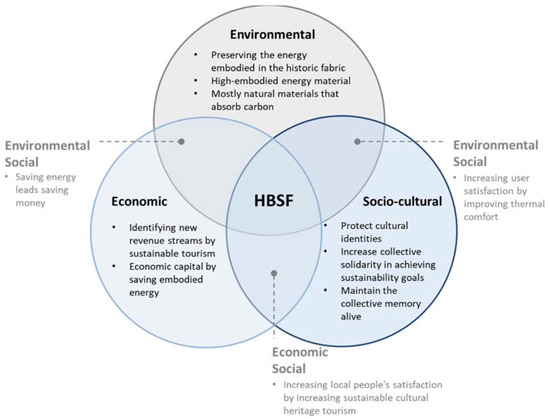
Figure 1.
Historical Buildings Sustainability Features (HBSF) (the figure was developed by the authors, inspired from [13,16,20,21]).
1.1. Sustainability Rating Systems
Sustainability rating systems are sets of standards for promoting sustainability in the construction industry [22]. A review of the existing rating systems reveals different sustainability indicators and systems are used for assessment. Indicators (e.g., as defined in ISO 21929 [23]) enable information on a complex phenomenon, such as environmental impacts, to be converted into a simple form that is relatively easy to use and understand. The construction sector can benefit from the sustainability indicators to make more informed decisions in the design, construction, and management of buildings while addressing the economic, environmental, or social aspects.
Rating systems measure environmental aspects such as energy, land, water, and materials [24]. These systems perform data analysis, evaluation, and comparison to achieve three main goals: minimizing the environmental impact, assessing the impact of the building on the environment, and the sustainable development of building projects [25] Rating systems can evaluate a building based on its predicted performance throughout its life cycle, from design to operation [24]. This leads to the development of design solutions or interventions that consume fewer natural resources without compromising the occupants’ acoustic, thermal, and visual comfort. Likewise, the use of rating systems allows for the comparison and benchmarking of buildings and a mechanism to inform decision making regarding the design and operation of the best buildings for their occupants [24].
The majority of areas covered by sustainable rating systems are energy, water consumption, resource use, waste management, indoor air quality, ecology, operation and maintenance, and innovation and, for some rating systems, economic and social impacts [25]. Several sustainability assessment tools exist worldwide today, focusing on different areas of sustainable development and designed for different types of projects. However, only a few systems are widely accepted and truly set a recognizable standard for sustainable development, such as LEED, BREEAM, GRIHA, DGNB, GREEN STAR, CASBEE, etc. In this regard, many papers compared rating systems. In the following, we provide a summary of these works.
The context and climate are effective factors in creating a building. Furthermore, contextual and climatic differences are prominent in preserving today’s resources and transferring them to the next generation. In this regard, some researchers believe that climate and context are not considered in most existing rating systems, and there is no flexible weighting system that allows adjustment of local priorities [26]. For instance, Badawy and Shahda [27], based on analyzing the GPRS (Green Pyramid Rating System), discussed that the climate variety of the vast country of Egypt is not predicted in this system, and they recommended revising the weighting of indicators. Adaptation of rating systems is one of the solutions that Santius [28] tested to deal with the context challenge in the residential space. Concerning the importance of climate and context, another example is comparing the Green Rating for Integrated Habitat Assessment (GRIHA) and Leadership in Energy and Environmental Design (LEED), which revealed that the GRIHA system is generally more compatible with Indian conditions [29,30]. Each country’s cultural background and different needs are also crucial in developing rating systems. Sharma and Louzado [31] compared the rating systems of India and Japan. The study showed that the priority in India’s rating system was to reduce costs. In comparison, Japan’s rating system emphasizes natural disasters. Furthermore, the Japanese have more cooperation in achieving sustainability goals. Therefore, the Japanese rating system has a stricter framework [31].
There are similarities in the goal, approach, and structure of rating systems. In contrast, there are differences in environmental issues, performance measures, and standards [32]. Moreover, there are great varieties between levels in each system, and this issue complicates the comparison of rating systems [33]. For example, the highest level of the LEED system (palladium) is not equivalent to the highest degree of BREEAM (excellent) in terms of sustainability characteristics or environmental effects [33].
LEED and BREEAM systems are at the top in terms of availability, method, application, data collection process, verification, user friendliness, and development [34]. Therefore, a great deal of research has been done on these systems [35]. The studies on LEED showed that the main focus of the LEED system is on energy [35]. Furthermore, using the LEED system reduces energy consumption in buildings with high-level certificates (gold, palladium). On the contrary, energy consumption in low-certified (certified) buildings was not different than in non-certified buildings [36]. There is diversity, adaptability, and coherence in the LEED system that demonstrates the resilience of this system [37]. Nevertheless, LEED performs better in small buildings compared to larger buildings [38]. Furthermore, exploring 1500 energy credit LEED projects indicates a direct relationship between high-energy performing buildings and their owners or developers [39]. From another point of view, applying the LEED rating system to two buildings from two countries with different climates and cultural backgrounds has different results [40]. Despite obtaining the highest level (gold) in both buildings, the energy efficiency of one was higher than the other [40]. Overall, the comparison of different rating systems in the world shows that the majority of existing systems measure environmental impact rather than sustainability [41], among which, the German Deutsche Gesellschaft für Nachhaltiges Bauen (DGNB) system comes closest to an equal focus on each sustainable dimension, i.e., economy, society, and environment [42]. In the following, we present a brief summary on the three most popular rating systems in the world, including LEED, DGNB, and BREEAM.
1.1.1. Leadership in Energy and Environmental Design (LEED)
LEED is the most broadly used rating system worldwide, which was developed by US Green Building Council in 1998. According to LEED credits, existing buildings and buildings under construction can be certified using the LEED rating system, which includes four levels: platinum, gold, silver, and certified. LEED has seven basic criteria: sustainable site, water efficiency, energy and atmosphere, material and resources, indoor environmental quality, innovation and design, and regional priority (see Figure 2). Meanwhile, the energy criterion has the highest score [43,44].
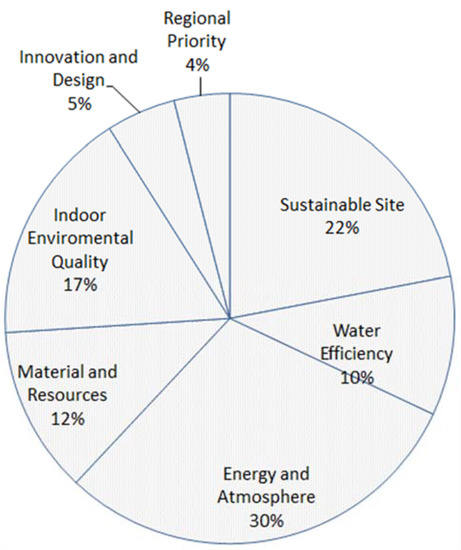
Figure 2.
LEED categories according to [44].
1.1.2. Deutsche Gesellschaft für Nachhaltiges Bauen (DGNB)
For the first time, DGNB was launched in 2009. Unlike other systems, in this rating system, equal attention is paid to the three dimensions of sustainability, i.e., social, economic, and environmental (see Figure 3). The DGNB system includes three other categories of less important weight factors: technical, process, and site quality. Total points lead to certification at four levels: DGNB bronze (35 points), DGNB silver (50 points), DGNB gold (65 points), and DGNB platinum (80 points) [45,46].
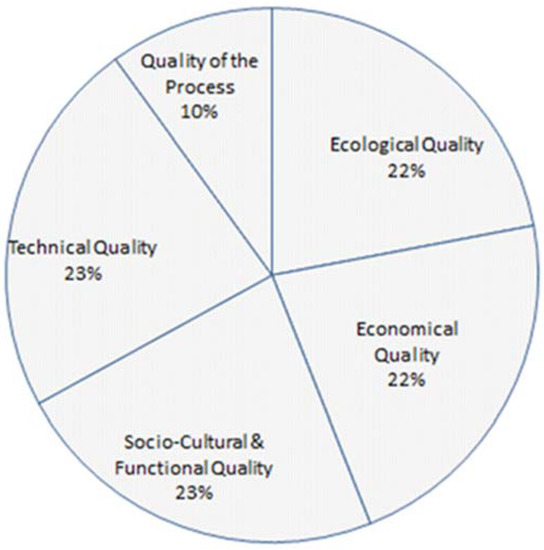
Figure 3.
DGNB categories according to [46].
1.1.3. Building Research Establishment Environmental Assessment Method (BREEAM)
BREEAM is the first total quality-assessment system in the world that was established by the British in 1990. In this system, the main indicators include management, health and welfare, energy, transportation, water, materials, waste, land use and ecology, pollution, and innovation. Depending on the number of points, the awarded buildings can be classified as unclassified (less than 30 points), Accepted (30 points), good (45 points), very good (55 points), excellent (70 points), and excellent (85 points) (Figure 4) [47,48].
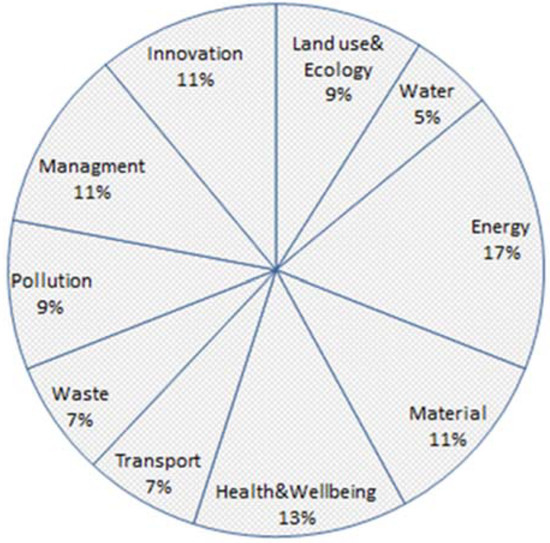
Figure 4.
BREEAM categories according to [47].
The comparison of indicators in each system showed that 55% (on average) of the focus is on the environmental dimension. The social dimension accounted for an average of 30% of the weighting across the three. Apart from these three systems, LEED and BREEAM assigned the lowest degree (5% and 2%, respectively) to the economic dimension. In the contrary, DGNB pays the most attention to the economy (60%). Overall, a more balance between the three dimensions of sustainability can be observed in the DGNB system (Figure 5) [49].
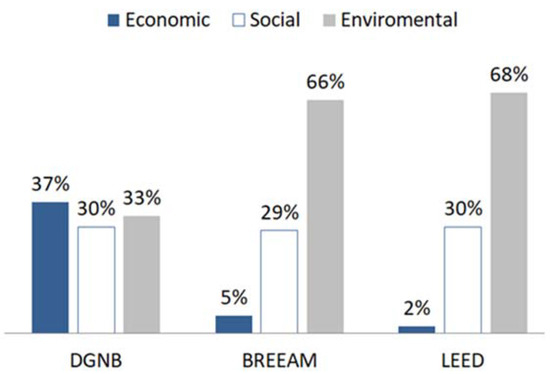
Figure 5.
Comparison between LEED, BREEAM, and DGNB (reproduced from [49]).
1.2. Aims and Scope
This paper aims to study and explore sustainability-rating systems focusing on their application to historic buildings. This is an effort towards conceptualizing and developing new/adapting existing rating systems particularly tailored for the sustainability assessment of historic buildings. It is the hypothesis of this paper that the use of sustainability rating systems in developing design interventions for the intervention of historic buildings can help them achieve more sustainable outcomes. In this perspective, the seven major contributions of this paper corresponding to the aim of the paper are structured as follows:
- (a)
- Identify the most popular sustainability rating systems worldwide and investigate the reasons for their popularity;
- (b)
- Identify and compare different existing rating systems in terms of their overall coverage over the three classical pillars of sustainability: society, economy, and environment;
- (c)
- Review different ways of calculating the rating systems;
- (d)
- Identify and compare existing rating systems with a focus on their application for (a) renovation or refurbishment of ordinary buildings and (b) renovation or refurbishment or preservation or conservation of historical buildings;
- (e)
- Investigate the main characteristics (e.g., building functions, building age, specific building values, assessment specifications, etc.) and the major differences of the existing rating systems, which have already been adapted for buildings with historical values, against the other existing systems;
- (f)
- Identify and elaborate different categories and criteria in the existing rating systems that are more relevant to historical buildings or have gained more attention in the previous studies with their application and focus on historic buildings;
- (g)
- Review and compare significant measures and intervention strategies concerning the most relevant sustainability criteria for renovation/preservation of historical buildings;
This paper is divided into five sections: Introduction, Methodology, Systematic Review Results, Discussion, and Conclusion. The methodology section (Section 2) explains the procedures used when conducting the systematic review of the literature. Section 3 presents an overview of key findings from the literature pertaining to their subjects and links those findings to the main thread of the review. The material reviewed in the preceding section is then discussed in Section 4, and the conclusions and recommendations for future studies are presented in the final section (Section 5).
2. Materials and Methods
This section provides an overview of the systematic review framework conducted for literature and previous research on sustainable rating systems with a focus on their application to historic buildings. This systematic review follows PRISMA (Preferred Reporting Items for Systematic Re-views and Meta-Analyses) guidelines (as presented in Figure 6 and Figure 7) by Page et al. [50], based on Liberati et al. [51]. In this framework, we identified the available literature on sustainability and historic buildings by searching Science Direct and Google Scholar. We searched for articles published in English from 2010 until 2022. Since the issue of sustainability is very broad and has many sub-categories, in the first step, the general keywords were used, including “sustainability” and “conservation” or “rehabilitation” or “renovation” and “historic building” or “historical building” or “built heritage”. Then, a subset (sustainable rating system) related to sustainability was searched separately in combination with the keywords “cultural heritage” or “historical buildings”. Due to the enormous amount of search hits in Google Scholar, for only the first 40 pages (due to the exceeding number of “grey literature”—or articles not formally published by commercial academic publishers—occurring on average at page 20 to 30 as a majority of each page in Google Scholar [52]), 10 results per page were screened. The search yielded 1150 articles by “sustainability “and “conservation” or “rehabilitation” or “renovation” and “historic buildings” or “historical building” or” built heritage” keywords and 240 articles by “historical building” or “historical buildings” keywords.
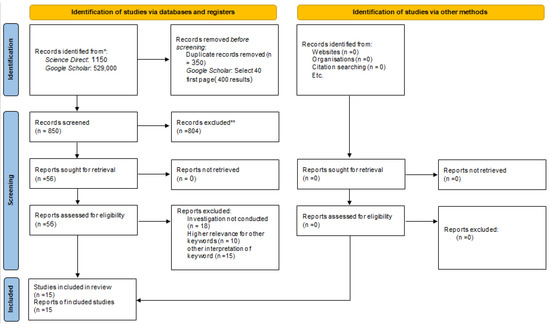
Figure 6.
Example PRISMA diagram for keywords: “sustainability” and “conservation” or “rehabilitation” or “renovation” and “historic buildings” or “historical building” or “built heritage”. [PRISMA instruction: * Consider, if feasible to do so, reporting the number of records identified from each database or register searched (rather than the total number across all databases/registers); ** If automation tools were used, indicate how many records were excluded by a human and how many were excluded by automation tools.].
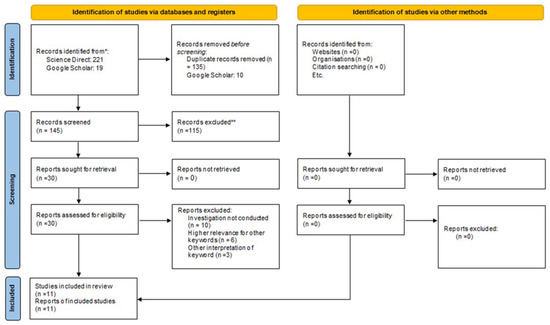
Figure 7.
PRISMA diagram for keywords: “sustainable rating system” and “historical building” or “historical buildings”. [PRISMA instruction: *Consider, if feasible to do so, reporting the number of records identified from each database or register searched (rather than the total number across all databases/registers); **If automation tools were used, indicate how many records were excluded by a human and how many were excluded by automation tools.].
The systematic review was carried out in several stages:
- (a)
- For “sustainability “and “conservation” or “rehabilitation” or “renovation” and “historic building” or “historical building” or “built heritage” keywords: first, the number of duplicate articles between Google Scholar and Science Direct was removed (350 articles). Among these, the title and abstract of 850 articles were screened. Then, 56 related articles were identified. Out of 56 articles, 18 articles were not directly related to historic buildings. Overall, 10 articles were about the structural sustainability of historical buildings, and 15 articles were not directly related to the topic of sustainability.
- (b)
- For “sustainable rating system” and “historical building” or “historical buildings” keywords: first, the number of duplicate articles between Google Scholar and Science Direct was removed (135 articles). Among these, the title and abstracts of 115 articles were screened. Then, 30 related articles were identified. Out of 30 articles, 10 articles were not directly related to historic buildings. Six articles were about the structural sustainability of historical buildings, and three articles were not directly related to the topic of sustainability.
Overall, 22 articles are directly related to environmental sustainability in historical building interventions. Two articles are related to the economic dimension, and one exclusively addresses historical buildings’ sustainable social aspects. Table A1 (in Appendix A) lists all the reviewed papers (for the table, see page 17).
3. Systematic Review Results
3.1. Sustainable Rating Systems in Historical Building
Historical buildings have a special character of historical and cultural value. In this regard, researchers believe that none of the sustainable rating systems can be directly applied to historical buildings [19]. Therefore, the unique nature of the historic building requires adapting existing criteria and adding new criteria that are not covered in any of the studied rating systems [19].
Considering the necessity of adapting historical buildings to new applications, applying third-party certification can be a valuable tool for directing the building sector towards sustainable development. The use of the rating system specific to historical buildings during the intervention process allows the building to maintain its historical and cultural identity while meeting the daily needs of today’s world [53,54]. GBC Historic Building (GBC HB) is an Italian rating system to improve environmental sustainability in intervention processes of historic buildings built before the end of World War II towards sustainability goals [55]. GBC HB is based on LEED (LEED NC 2009 Italia) [56], which allows for achieving a balance between the various requirements related to energy efficiency, environmental sustainability, interior comfort, and historical values [57]. A new category called historical value is introduced in the GBC rating system. Credits for the subject of historical value are based on principles such as minimum intervention, potential return, and compatibility, which fully comply with the requirements of the intervention [58]. GBC HB is used for buildings that were built before 1945 and at least remain 50% of their technical elements. Historical Building Identity Card is an information form to assess whether a historic building meets the scope of the rating system or not [59]. Overall, the special needs of preserving the cultural and artistic value of historical buildings and the topics of energy optimization and thermal comfort (according to protocol LEED Italy 2009) [56] are combined in this system to provide a sustainability assessment appropriate for historical buildings (see Figure 8) [60].
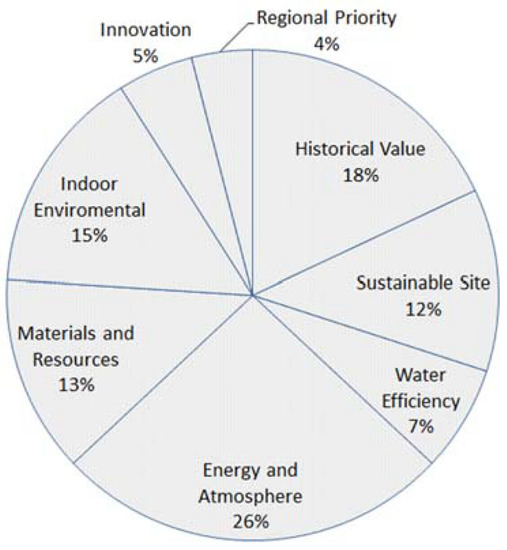
Figure 8.
GBC Historic Building (GBC HB) system indicators according to [54].
The application of rating systems on historical buildings had positive results, especially in terms of energy improvement. Using a new approach to retrofitting based on the GBC HB in an Italian historical building, the results before and after retrofitting showed an overall 40% increase in energy efficiency [60]. The work in [61] used GBC HB as an operative tool for a sustainable retrofit design of a historic high school. The results revealed that besides preserving the historical value of the building, the integrated design improves energy performance and internal thermal comfort. The framework also provided the best choice of intervention using a multi-criteria decision-making system, which led to an economically viable solution and a reduction in the 39% of energy consumption in building case (a school building). In terms of scores in the Italian certificate system, the project received a silver level [61]. In another project, using the Istituto per l’innovazione e Trasparenza degli Appalti e la Compatibilita Ambientale (ITACA), the possibility of increasing the energy performance of a historical complex named Albergo dei Poveri was examined. Applying the rating system to this complex showed that even if the total score is not high, it improves the restoration quality from an environmental perspective [15].
3.2. Life Cycle Assessment in Historical Building
The life cycle assessment (LCA) is a method that assesses the environmental impact of a material, product, or process throughout its whole life cycle [62]. The life cycle of a building can be studied from three different sustainability dimensions. The environmental LCA analysis is standardized under the ISO 14040-14043 regulations, which provide the specific guidelines for conducting the environmental assessment [63]. The conversion of environmental effects into monetary units and the assessment of economic sustainability can be seen in the LCC method [64]. The social dimension of sustainability and the assessment of impacts on stakeholders throughout the life cycle are based on the S-LCA method [65]. The sum of these three methods can be summarized in LCSA (LCSA = LCA + LCC + S-LCA). LCSA (Life Cycle Sustainability Assessment) is the life cycle sustainability assessment that extends the scope of the current environmental LCA to embrace the other two dimensions of sustainability to understand the fundamental interactions between nature and society [66].
Although the LCA method for selecting and evaluating materials has become common in new constructions, it has rarely been applied in the intervention process of historical buildings [67]. Historical buildings release different amounts of carbon during their life cycle. Appropriate interventions on historic buildings can help to reduce and eliminate carbon. Carbon emissions in historic interventions can be examined at three levels low changes (preservation, conservation), middle changes (rehabilitation), and large changes (renovation, restoration) [68]. All three levels of intervention have different subgroups: emissions from the production of new materials, emissions from the transportation of new materials for intervention and transportation of waste processing and disposal during the end of life of a component, emissions from intervention operations such as the installation, and replacement of new materials [68].
Choosing the most compatible type of intervention with environmental sustainability and increasing the use of renewable energy in the intervention process must be considered after calculating the carbon released at different levels of interventions in historical buildings [68]. For example, in research, a 22.9% reduction in life cycle energy consumption was observed due to appropriate intervention [69].There are a set of interventions phases that can be applied to an existing building (Figure 9). Table A2 (in Appendix A) listed all interventions types (for the table, see page 19).
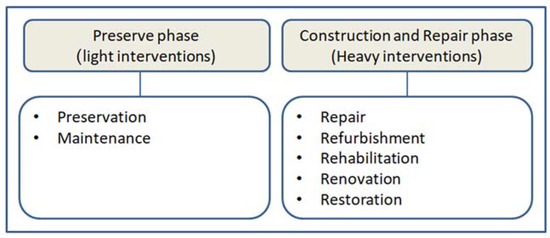
Figure 9.
Different phases of intervention in historical buildings.
Using the LCA in the category of historical building, it is possible to examine the extent of interventions in historical buildings and make the best decision [70]. In a study with the combination of LCA and the application of qualitative criteria, three scenarios are considered for the refurbishment of Sesga House in Valencia: (1) refurbishment of the house using local materials and traditional techniques, (2) refurbishment using widely used industrial materials, and (3) complete demolition of the historic building and new construction with using widely used industrial materials. The results show refurbishment instead of demolition as well as use of vernacular materials with a natural low-carbon footprint in the refurbishment process will reduce environmental pollution [70].
Designing the historical building life cycle management operating model for a historical building by the three pillars of sustainability allows the restoration process not to be closed after completion but to monitor the state of conservation of historical buildings with the ability to repeat sustainability life cycles to control the fulfillment of the objectives of conservation [71].
3.3. Energy in Historical Buildings
Historical buildings are compatible with the climate of each region. The building form of historical buildings often leads to thermal comfort and higher energy efficiency. For example, a comparative study of a historic and modern hotel in the city of Nablus on the thermal analysis shows that the studied historic building (Khan Hotel) is more energy-efficient than the newly built hotel [72].
Solar panels are often used in intervention in historic buildings to reduce carbon emissions. For example, a study of five historic buildings in the UK showed a reduced carbon emissions by 19% by installing solar panels on the roof [73]. Likewise, the use of solar panels in UNESCO villages that do not have access to electricity was successful [74]. The integration of high-tech energy measures such as photovoltaic (PV) systems with historical buildings requires an approach based on scientific knowledge [75]. Interventions in historical buildings should be based on three main criteria: invasiveness, reversibility, and compatibility. In this regard, a study was conducted on the location of solar panels in historic buildings [20]. Analyzing the installation of solar panels in four historical buildings reveals that the analyzed projects did not meet two out of the three evaluation criteria indicated by the UNI EN 16883:2017 standard [3], referring to the assessment category historical building significance of the building and its settings [76]. The integration of solar panels in a historic building can negatively affect the integrity and identity of the historic building [77]. After reviewing the implemented projects in [74], it is concluded that the most appropriate solution for the proper integration of solar panels with historical buildings is to expose the solar panels in historical buildings. These solar panels have been used in a way that contributes to cultural enjoyment and production [78].
3.4. Socio-Cultural Sustainability and Historical Buildings
In the social dimension of sustainability, culture has been mentioned as an aspect of social sustainability and occasionally even as an aspect or dimension of its own [21]. The relationship between culture and sustainable development was discussed during the UNESCO decade of culture and development (1988–1997), which was presented as a report entitled Our Creative Diversity [21]. In historical buildings, the material and immaterial aspects of historical buildings are interrelated. For example, cultural viability and local identity are affected by the context of the landscape [79]. Cultural sustainability can recover and protect cultural identities [80]. For instance, one of the cultural sustainability measures is preserving the traditional celebrations of each region and handed on to future generations. Globalization has negatively affected cultural sustainability. Hence, a vital challenge remains in protecting historical buildings from growing globalization [81].
3.5. Economic Sustainability in Historical Buildings
From an economic point of view, historical buildings are capital, and their conservation is an investment in the future. However, this does not mean that historical buildings are defined only by economic attractions because, in the long run, this will cause damage to the historical building and the emergence of approaches such as disneyfication or facadism, in which only economic attractiveness is considered. Therefore, economic sustainability is a necessary condition in historical buildings, but it is not sufficient [82]. Improving financial management at historical building sites has several benefits, including better use of existing resources and identifying new revenue streams. Financial control of historical buildings should be taken over by those who pay attention to the aesthetic, historical, and scientific values of historical buildings. This attention prevents the over-commercialization of theme. Improving financial management results in reduced preventive maintenance costs and improved long-term conservation. The study in [6] surveyed 28 world historical building sites in the Mediterranean geography and conducted 36 interviews with site managers and experts. The result of this analysis led to a better understanding of the historical building management sites and the creation of five indicators for greater financial sustainability (Table 1) [7].

Table 1.
Circumstances toward greater financial sustainability (according to [6]).
4. Discussion
In this paper, our aim (as elaborated in Section 1) is to study and explore sustainability-rating systems focusing on their application to historic buildings. We conducted a systematic review in several different categories. This section presents the results of reviews. It is structured into seven rows based on the seven research contributions presented in Section 1.
(a) Study and analysis of the background of research in the field of rating systems worldwide: It is revealed that the most popular rating systems in the world are LEED, BREEAM, and DGNB. Globally, LEED is used in Asia, Europe, and America. BREEAM and DGNB are the most popular systems in the European continent [48]. Climatic and context differences have a direct impact on the foundations of sustainability. However, in most of the world’s rating systems, vernacular issues are not taken into account [26].
(b) Identify and compare different existing rating systems: In recent years, the attention of the construction industry to the issue of sustainability has increased. Accordingly, the review of related articles from 2010 to 2022 shows a significant increase in publications since 2014 (Figure 10). Most rating systems focus on the environmental dimension of sustainability. Among the rating systems, DGNB pays equal attention to all three pillars (environmental, economic, and social) of sustainability. Furthermore, most research has been done on LEED.
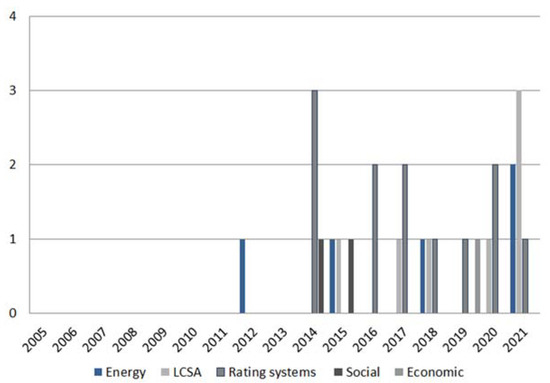
Figure 10.
Number of publications per year.
(c) Ways of evaluation and calculation in sustainable rating systems: Each rating system has different calculation methods to evaluate the level of sustainability in buildings (Figure 11). For instance, the highest level of LEED system (palladium) is not equivalent to the highest degree of BREEAM (excellent) in terms of sustainability characteristics or environmental effects [31]. The sum of points obtained from different indicators creates different levels in each rating system. In DGNB, total points lead to certification at four levels: DGNB bronze (35 points), DGNB silver (50 points), DGNB gold (65 points), and DGNB platinum (80 points). Depending on the number of points, the awarded buildings can be classified as accepted (30 points), good (45 points), very good (55 points), excellent (70 points), and outstanding (85 points). LEED includes four levels: certified (40–49 points), silver (50–59 points), gold (60–79 points), and platinum (80+ points).
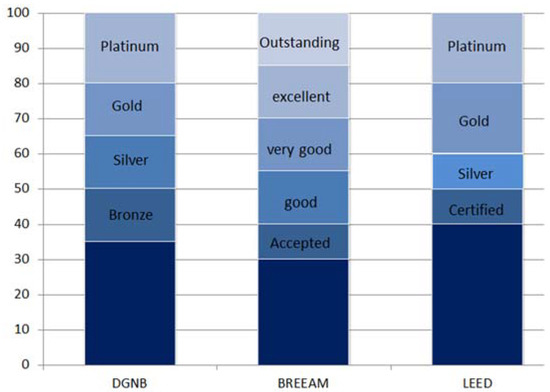
Figure 11.
Different certification levels/awards/scores in sustainable rating systems.
Our literature review reveals that the use of LEED in highly scored buildings (palladium) is significantly effective in reducing energy, while the use of LEED in low-level structures (certified) has no difference with buildings without LEED certification [36]. Calculating the energy performance in LEED is associated with weaknesses in large buildings. This is while the performance of energy calculation in small buildings has more accurate results [38].
The location of the building affects the achieved certification level. For example, a building with a gold certificate in Turkey does not have the same energy efficiency as a building with a gold certificate in Europe [40]. Overall, it is not possible to accurately compare rating systems due to the difference in indicators and weightings.
(d) Compare existing rating systems with a focus on intervention in historic buildings: It is evident that most of the sustainable rating systems developed to achieve sustainability goals are applicable for only new construction projects. However, many rating systems have frameworks for intervention in existing buildings that are not very established or advanced. Many studies point out that none of the existing rating systems are suitable for use in historical buildings [19]. One of the important reasons for the inappropriateness of the systems is neglecting the historical values and unique identity features of cultural heritage in existing rating systems [53,54].
(e) Sustainable rating system adapted for historical buildings: The only rating system for historical buildings is the GBC HB Italy, which focuses mainly on environmental dimensions [57]. The main goals of this rating system are indoor environmental comfort and the sustainable use of resources, i.e., materials, energy, land, and water. A new historical value section, based on principles such as minimum intervention, potential return, and compatibility and fully compliant with restoration requirements, has been added to the Italian LEED rating system [58]. This sustainable rating system is used for buildings that were built before 1945, which at least 50% of their technical remaining elements [56]. Applying GBC HB Italy to historic buildings in Italy has led to some cases of reducing energy consumption and economic savings. However, one of the disadvantages of GBC is that it does not include the socio-cultural and economic aspects of sustainability [60,61].
(f) Sustainable categories in previous studies: Many reviewed literature echo that historical buildings have a significant potential to contribute to environmental sustainability. For instance, the energy consumption for the construction of a new building (from the production of materials to transportation and construction of the building) is approximately equal to the energy consumed by an existing building for 10 years [18]. Thus, this amount of energy results in a significant savings of economic capital. Therefore reusing the historical buildings prevent generating or wasting extra energy compared to the new buildings [83]. The materials of historic buildings are often produced from local sources, which results in less transportation and pollution. Furthermore, most materials are constructed from natural materials. Materials such as straw, hemp, and lime can absorb carbon. Other materials, such as stone and brick, have a high-energy content [84].
In the conducted research, among the sustainability goals in historic buildings, more emphasis has been placed on increasing energy efficiency and life cycle impacts of historical buildings [68,69,70,71]. On the other hand, less attention has been paid to the cultural and economic dimensions of cultural heritage. More than 80% of the reviewed articles are related to the environmental sustainability of historic buildings. However, a few of the articles were related to economic and social aspects (as presented in Figure 12a). This highlights that solving environmental problems is one of the priorities of the historical building industry. Among these, the most comprehensive research that includes all sustainable environmental indicators was related to rating systems (as presented in Figure 12b).

Figure 12.
(a) Percentage of relevant articles on each topic; (b) percentage of relevant articles in Environmental dimension.
Social and economic sustainability challenges and issues in historical buildings have also been studied. Improving financial sustainability in managing historical building sites by providing five main indicators (including LCC) is a solution to address the weaknesses of financial management of historical building sites [7,71,82]. On the other hand, culture is also one of the essential themes of the social sustainability dimension of historical buildings [81]. Cultural sustainability has a direct impact on the protection of historical building identity. Hence, it has the potential to be considered an independent dimension of social sustainability in historical building sustainability issues. Applying S-LCA standards [71] can also effectively promote social sustainability in historical buildings. Sustainable intervention is directly related to the consensus and support of stakeholders. Therefore, stakeholder expectations must be considered and addressed as well.
(g) Interventions strategies relevant to sustainability criteria for renovation/preservation of historical buildings: Various intervention strategies are related to sustainability criteria in historical buildings. In all executive measures (such as insertion, integration, replacement, overlapping, interposition strategies) [76,85,86] to preserve the historic building and improve its sustainability, the principles of reversibility of actions and maintaining the authenticity of the historic building must be followed. The best alternative for reducing the amount of carbon emission during the life cycle of the historic building is to refurbish buildings with vernacular materials [70]. Furthermore, calculating the amount of carbon produced during different phases of intervention in historic buildings can help select the best alternative for rehabilitation/renovation/protection according to the sustainability requirements of the historical buildings.
5. Conclusions and Recommendations for Future Research
This paper reviewed previous research on sustainable rating systems with a focus on historic buildings. In terms of the three classical pillars of sustainability, i.e., economic, social, and environmental sustainability, most of the focus has been on addressing environmental sustainability criteria. Most of the articles focus on increasing energy efficiency as an improvement to historic buildings’ environmental sustainability, which results in lowering economic costs and increasing occupant satisfaction with the indoor environment. The review showed that researchers often believe no sustainable rating system can be directly applied to historic buildings. Therefore, the unique nature of the historic buildings requires adapting existing criteria and adding new ones that are not covered in any of the studied rating systems. The only sustainability system adapted to historical buildings so far is the Italian GBC HB, which focuses on the environmental dimension of sustainability, especially improving the energy efficiency of historic buildings. Future rating systems should be developed or updated according to cultural heritage needs, and for the sustainable survival of cultural heritage, the socio-cultural and economic aspects are equally important. In this light, the application and adaptation of more balanced rating systems such as the German DGNB system will be more relevant due to its coverage of sustainability goals and criteria in all three social, economic, and environmental dimensions [87].
There were limitations to the research process that have to be taken into account. First, the search was done in English, and the articles were collected and studied in English. Since the category of historical buildings is international and related to all cultures, there is undoubtedly research carried out in the national language of each country that was not included. Second, it was not possible to access all documents of world rating systems. Furthermore, the search combined keywords with “sustainability” or “sustainability rating system” and “historic buildings”, meaning that these keywords were mentioned in the abstract or title of the publication (Science Direct) or the full publication (Google Scholar). For this reason, articles with a focus on energy or LCA were excluded from the study.
Consistent with the content of this paper, there is potential for further research involving the development of a rating system for historic buildings. Future work can explore strategies to add context and climate to existing rating systems. In this light, the development and addition of new criteria and indicators to address and preserve the unique cultural characteristics of historic buildings and promote economic sustainability should be prioritized within future sustainable rating systems for historic buildings.
Author Contributions
Conceptualization, F.K. and A.K.; methodology, F.K.; software, F.K.; validation, F.K., A.K., and N.V.; formal analysis, F.K.; investigation, F.K.; resources, F.K.; data curation F.K.; writing—original draft preparation, F.K.; writing—review and editing, F.K. and A.K.; visualization, F.K.; supervision, N.V., G.M., and A.K.; project administration, A.K.; funding acquisition, A.K. All authors have read and agreed to the published version of the manuscript.
Funding
This research received no external funding.
Informed Consent Statement
Not applicable.
Data Availability Statement
Not applicable.
Conflicts of Interest
The authors declare no conflict of interest.
Appendix A

Table A1.
Summary of included studies reporting on sustainability in historical building.
Table A1.
Summary of included studies reporting on sustainability in historical building.
| Authors | Year | Field of Study | Results |
|---|---|---|---|
| M, Salameh B, Touqan, M, Awad [72] | 2021 | Energy | A comparison of a modern hotel building with a historic hotel showed that the historic building has higher thermal comfort and energy efficiency than a modern hotel. |
| S, De Medici [76] | 2021 | Energy | Investigating the best method for integrating solar panels in buildings by considering the principles of reversibility and authenticity of the historic building. |
| Mileto, C. Vegas, F. Llatas, C [70] | 2021 | LCA | Selection of the most compatible materials with the principles of sustainability for the refurbishment of a historic house with the LCA method. |
| N, Atmaca A, Atmaca A, Özçetin [69] | 2021 | LCA | 22.9% reduction in life cycle energy consumption was observed due to appropriate intervention. |
| A, Al-Sakkaf T, Zayed [83] | 2020 | Rating systems with a focus on their application for historical buildings | None of the rating systems provide definitive guidelines for the best cost-effective rehabilitation option with considering building sustainability. Therefore, it should develop a rating system for historical buildings that not only evaluates the different components of the building but also optimizes costs. |
| E, Lucrezia V, Bonoli [67] | 2020 | LCA | The application of the life cycle in the field of restoration of historical monuments, with special reference to cleaning, leads to the analysis of seven cleaning methods with the LCA approach. |
| A, Al-Sakkaf Z, Tarek B, Ashutosh [19] | 2019 | Rating systems with a focus on their application for historical buildings | A study of 12 rating systems showed that these systems have significant weaknesses in some indicators such as energy for historical buildings. |
| J, Grinda [7] | 2019 | Sustainable financial management | Redefining financial sustainability in the management of historical building sites by creating 5 main components to achieve this goal: management planning, revenue identification, expenditure analysis, administration and strategic planning alignment and support of cultural, and educational and conservation mission. |
| P, Boarin E, Lucchi M, Zuppiroli [54] | 2019 | Rating systems with a focus on their application for historical buildings | Introduction and analysis of the GBC historic building, which was developed in 2014. |
| C, Bertolin, A, Loli [68] | 2018 | LCA |
|
| D, Settembre A, Blundo F, Alfonso E, García Muina [71] | 2018 | LCA | Turning the Historical building Lifecycle Management protocol into a model and ultimately creating a suitable tool for the conservation and restoration of historic buildings. |
| G, Franco [74] | 2018 | Energy | The use of solar panels in UNESCO villages that do not have access to electricity was successful |
| V, Castaldo A, Pisello P, Boarin A, Petrozzi F, Cotana [60] | 2017 | Rating systems with a focus on their application for historical buildings | Using GBC HB as an operational tool for sustainable retrofit design in a historic school resulted in 39% building energy savings. |
| M, Baggio C, Tinterri T, DallaMora F, Peron P, Romagnoni [61] | 2017 | Rating systems with a focus on their application for historical buildings | The use of “GBC HB” in the retrofitting of an Italian historical building showed a reduction of 40% in energy consumption in the building after the retrofitting. |
| E, Lucchi P, Boarin M, Zuppiroli [53] | 2016 | Rating systems with a focus on their application for historical buildings | Introduction and analysis of the GBC historic building, which was developed in 2014. |
| P, Boarin [57] | 2016 | Rating systems with a focus on their application for historical buildings | Analysis of GBC historical building and propose a new adaptation in a subset of “GBC family”, which named is GBCHome®. |
| A, Magrini G, Franco M, Guerrini [15] | 2015 | Rating systems with a focus on their application for historical buildings | Applying the ITACA system to the monumental complex increased energy efficiency and improved restoration measures from an environmental perspective. |
| F, Moran, S, Natarajan [73] | 2015 | Energy | Study of 5 historic buildings in the UK showed that installing solar panels on the roof reduced carbon emissions by 19% |
| M, Pertosa V, Castaldo A, Pisello F, Cotana [58] | 2014 | Rating systems with a focus on their application for historical buildings | Two actions result in high environmental sustainability in the historical building stability of Italy:
|
| P, Boarin D, Guglielmino M, Zuppiroli [59] | 2014 | Rating systems with a focus on their application for historical buildings | Introduction and analysis of the GBC historic building, which was developed in 2014. |
| Soini, K Birkeland, I [81] | 2014 | Socio-cultural sustainability and historical building | Understanding the place of culture in the issue of sustainability. |
| P, Godwin [18] | 2011 | Energy | The maintenance of historical buildings is in line with the goals of sustainability for the following reasons:
|

Table A2.
Definitions of interventions applied in historic building.
Table A2.
Definitions of interventions applied in historic building.
| Type of Intervention | Definition |
|---|---|
| Preservation | All measures lead to maintaining the current status of the monument [68]. Maintaining a place in its existing state and retarding deterioration [88]. |
| Conservation | Includes all preventive protection measures and interventions that increase life and maintain the authenticity of the historical building [89]. All the steps of taking care of a place are for its cultural preservation [88]. |
| Maintenance | Includes both preservation and preventive conservation actions that are carried out during the life cycle of a building [90]. Continuous protective care of a place and its setting [88]. |
| Repair | Measures to recover the function or appearance of the historical building or part of it [65]. |
| Refurbishment | Includes the repair, renewal, and modification of a building to meet economic and/or functional criteria [90]. |
| Rehabilitation | Actions to change the use of the historic building in a way that is compatible with the building [65]. |
| Renovation | Actions to upgrade building components to today’s level, for example, improving energy efficiency in a historic building [68]. |
| Restoration | Action(s) to bring the existing building back to a former condition, returning a place to a known earlier state by removing accretions or by reassembling existing elements without the introduction of new material [88]. |
References
- Throsby, D. The concentric circles model of the cultural industries. Cult. Trends 2008, 17, 147–164. [Google Scholar] [CrossRef]
- CEN (European Committee for Standardization). Conservation of Cultural Heritage (Historic Timber Structures); Guidelines for the Site Assessment; European Committee for Standardization: Brussels, Belgium, 2017. [Google Scholar]
- Charter, K. Principles for Conservation and Restoration of Built Heritage; Marsilio: Venice, Italy, 2000. [Google Scholar]
- UNESCO. World Heritage Statistic; UNESCO World Report; UNESCO: Paris, France, 2018. [Google Scholar]
- Council of Europe. European Charter of the Architectural Heritage; Council of Europe: Strasbourg, France, 1975. [Google Scholar]
- ICOMOS. Principles for the Preservation of Historic Timber Structures. In Proceedings of the 12th General Assembly, Mexico city, Mexico, 17–23 October 1999; ICOMOS: Paris, France, 1999. [Google Scholar]
- Eppich, R.; Grinda, J. Sustainable financial management of tangible cultural heritage sites. J. Cult. Herit. Manag. Sustain. Dev. 2019, 9, 282–299. [Google Scholar] [CrossRef]
- World Commission on Culture and Development. Our Creative Diversity; EGOPRIM: Paris, France, 1995. [Google Scholar]
- European Council. In from the Margins: A Contribution to the Debate on Culture and Development in Europe; The European Task Force on Culture and Development; Council of Europe Publishing: Luxembourg, 1997. [Google Scholar]
- UNESCO. Hangzhou Declaration: Placing Culture at the Heart of Sustainable Development Policies. In Proceedings of the International Congress “Culture: Key to Sustainable Development”, Hangzhou, China, 14–17 May 2013. [Google Scholar]
- UNESCO. Protection and Promotion of the Diversity of Cultural Expressions; UNESCO World Report; UNESCO: Paris, France, 2005. [Google Scholar]
- Hein, C.M. World Heritage City Lab–Historic Cities, Climate Change, Water, and Energy; UNESCO: Paris, France, 2021. [Google Scholar]
- Cernea; Michael, M. Cultural Heritage and Development: A Framework for Action in the Middle East and North Africa; The World Bank: Washington, DC, USA, 2001. [Google Scholar]
- Di Giovine, M.A. The heritage scape: Origins, theoretical interventions, and critical reception of a model for understanding UNESCO’s World Heritage Program. Tour. Rev. 2018, 13, 185–197. [Google Scholar] [CrossRef]
- Magrini, A.; Franco, G.; Guerrini, M. The impact of the energy performance improvement of historic buildings on the environmental sustainability. Energy Procedia 2015, 75, 1399–1405. [Google Scholar] [CrossRef]
- Rasmussen, T.V.; Møller, E.B.; Buch-Hansen, T.C. Extensive Renovation of Heritage Buildings: Reduced Energy Consumption and CO2 Emissions. Open Constr. Build. Technol. J. 2015, 9, 58–67. [Google Scholar] [CrossRef]
- Tomšič, M.; Mirtič, M.; Šijanec Zavrl, M.; Rakušček, A. Energy renovation of cultural heritage buildings “by the book”. Procedia Environ. Sci. 2017, 38, 212–219. [Google Scholar] [CrossRef]
- Godwin, P.J. Building Conservation and Sustainability in the United Kingdom. The 2nd International Building Control Conference. Procedia Eng. 2011, 20, 12–21. [Google Scholar] [CrossRef]
- Al-Sakkaf, A.; Zayed, T.; Bagchi, A.; Mohammed Abdelkader, E. Sustainability rating tool and rehabilitation model for heritage buildings. In Proceedings of the CSCE Annual Conference, Laval, QC, Canada, 12–15 June 2019. [Google Scholar]
- Giuffrida, S.; Gagliano, F.; Nocera, F.; Trovato, M.R. Landscape assessment and economic accounting in wind farm programming: Two cases in Sicily. Land 2018, 7, 120. [Google Scholar] [CrossRef]
- Murphy, K. The social pillar of sustainable development: A literature review and framework for policy analysis. Sustain. Sci. Pract. Policy 2012, 8, 15–29. [Google Scholar] [CrossRef]
- Alwisy, A.; BuHamdan, S.; Gül, M. Criteria-based ranking of green building design factors according to leading rating systems. Energy Build. 2018, 178, 347–359. [Google Scholar] [CrossRef]
- ISO/TS 21929-1; Sustainability in Building Construction—Sustainability Indicators—Part 1: Framework for the Development of Indicators for Buildings. ISO: Geneva, Switzerland, 2011.
- Berardi, U. Sustainability assessment of urban communities through rating systems. Environ. Dev. Sustain. 2013, 15, 1573–1591. [Google Scholar] [CrossRef]
- Awadh, O. Sustainability and green building rating systems: LEED, BREEAM, GSAS and Estidama critical analysis. J. Build. Eng. 2017, 11, 25–29. [Google Scholar] [CrossRef]
- Suzer, O. A comparative review of environmental concern prioritization: LEED vs. other major certification systems. J. Environ. Manag. 2015, 154, 266–283. [Google Scholar] [CrossRef] [PubMed]
- Badawy, N.M.; Shahda, M.M. Green Worship House Competition as an Effective Tool to Evaluate Green Pyramid Rating System (GPRS). J. Sustain. Dev. 2020, 13, 18–32. [Google Scholar] [CrossRef]
- Santius, S.H. Adaptation of Rating System for Sustainable Housing and Settlements in Indonesia. KnE Soc. Sci. 2019, 1, 812–824. [Google Scholar]
- Kanaujia, V.; Reddy, A.S.; Kumar, K. Comparative Review of Indian Green Building Rating Systems. J. Energy Res. Environ. Technol. 2017, 4, 194–198. [Google Scholar]
- Pamu, Y.; Mahesh, K. A Comparative Study on Green Building Rating Systems in India in terms of Energy and Water. CVR J. Sci. Technol. 2019, 16, 21–25. [Google Scholar] [CrossRef]
- Sharma, R.; Louzado, D. Green Building Rating Systems: Comparative Review of IGBC Green Homes and CASBEE for Detached Homes. Earth Sci. Eng. 2015, 3, 793–805. [Google Scholar]
- Elmeligy, D.A. Rating Systems Awareness for Green Buildings Applications. Int. Refereed J. Eng. Sci. 2014, 3, 53–64. [Google Scholar]
- Reed, T.J.; Clouston, P.L.; Hoque, S.; Fisette, P.R. An analysis of LEED and BREEAM assessment methods for educational institutions. J. Green Build. 2010, 5, 132–154. [Google Scholar] [CrossRef]
- Nguyen, B.K.; Altan, H. Comparative review of five sustainable rating systems. Procedia Eng. 2011, 21, 376–386. [Google Scholar] [CrossRef]
- Aye, L.; Hes, D. Green building rating system scores for building reuse. J. Green Build. 2012, 7, 105–112. [Google Scholar] [CrossRef]
- Amiri, A.; Ottelin, J.; Sorvari, J. Are LEED-certified buildings energy-efficient in practice? Sustainability 2019, 11, 1672. [Google Scholar] [CrossRef]
- De Castro, D.; Kim, A. Adaptive or absent: A critical review of building system resilience in the LEED rating system. Sustainability 2021, 13, 6697. [Google Scholar] [CrossRef]
- Scofield, J.H. Do LEED-certified buildings save energy? Not really. Energy Build. 2009, 41, 1386–1390. [Google Scholar] [CrossRef]
- Gurgun, A.P.; Arditi, D. Assessment of energy credits in LEED-certified buildings based on certification levels and project ownership. Buildings 2018, 8, 2–29. [Google Scholar] [CrossRef]
- Aksit, Ş.F.; Bastanoglu, E. A review of LEED green building certification systems in Europe and Turkey. A Z ITU Mimar. Fakültesi Derg. 2021, 18, 115–126. [Google Scholar]
- Bernardi, E.; Carlucci, S.; Cornaro, C.; Bohne, R.A. An analysis of the most adopted rating systems for assessing the environmental impact of buildings. Sustainability 2017, 9, 1226. [Google Scholar] [CrossRef]
- Sanchez, C.A.; Gomez, S.; Andujar, M.; José, M. Green building rating systems and the new framework level(s): A critical review of sustainability certification within Europe. Energies 2019, 13, 66. [Google Scholar] [CrossRef]
- US Green Building Council. LEED v4 for Building Design and Construction; USGBC Inc.: Washington, DC, USA, 2014. [Google Scholar]
- LEED. Green Building Council, U.S. 2022. Available online: https://www.usgbc.org/leed (accessed on 5 May 2022).
- Eberl, S. DGNB vs. LEED: A comparative analysis. In Proceedings of the Conference on Central Europe towards Sustainable Building, Prage, Czech Republic, 30 June–2 July 2010; pp. 1–5. [Google Scholar]
- DGNB. German Sustainable Building Council, Germany, 2022. Available online: https://www.dgnb.de/en/index.php (accessed on 10 February 2022).
- BREEAM. Bre Group, UK, 2022. Available online: https://bregroup.com/products/breeam/ (accessed on 25 February 2022).
- Reed, R.; Bilos, A.; Wilkinson, S.; Schulte, K.W. International comparison of sustainable rating tools. J. Sustain. Real Estate 2009, 1, 1–22. [Google Scholar] [CrossRef]
- Jensen, K.G.; Birgisdottir, H.; Poulsgaard, K.S.; Lind, L.; Christensen, C.Ø.; Skjelmose, O.; Carruth, S.J.; Jensen, K.K.; Canera, I.O.; Manbodh, J.; et al. Guide to Sustainable Building Certifications; Aalborg University: Aalborg, Denmark, 2018. [Google Scholar]
- O’Dea, R.E.; Lagisz, M.; Jennions, M.D.; Koricheva, J.; Noble, D.W.; Parker, T.H.; Nakagawa, S. Preferred reporting items for systematic reviews and meta-analyses in ecology and evolutionary biology: A PRISMA extension. Biol. Rev. 2021, 96, 1695–1722. [Google Scholar] [CrossRef] [PubMed]
- Moher, D.; Liberati, A.; Tetzlaff, J.; Altman, D.G.; Prisma Group. Reprint—Preferred reporting items for systematic reviews and meta-analyses: The PRISMA statement. Phys. Ther. 2009, 89, 873–880. [Google Scholar] [CrossRef] [PubMed]
- Haddaway, N.R.; Collins, A.M.; Coughlin, D.; Kirk, S. The role of Google Scholar in evidence reviews and its applicability to grey literature searching. PLoS ONE 2015, 10, e0138237. [Google Scholar] [CrossRef]
- Lucchi, E.; Boarin, P.; Zuppiroli, M. GBC Historic Building®: A new certification tool for orienting and assessing environmental sustainability and energy efficiency of historic buildings. Energy Effic. Comf. Hist. Build. 2016, 4, 250–256. [Google Scholar]
- Boarin, P.; Lucchi, E.; Zuppiroli, M. An Assessment Method for Certified Environmental Sustainability in the Preservation of Historic Buildings. A Focus on Energy Efficiency and Indoor Environmental Quality in the Italian Experience of GBC Historic Building. Restor. Build. Monum. 2019, 24, 14–29. [Google Scholar] [CrossRef]
- Green Building Council. GBC Historic Building; Sistema di verifica GBC historic building®; Green Building Council Italia: Rovereto, Italy, 2014. [Google Scholar]
- Green Building Council Italia. Green Building Nuove Costruzioni e Ristrutturazioni; Sistema di Valutazione LEED NC 2009 Italia; Green Building Council Italia: Rovereto, Italy, 2011. [Google Scholar]
- Boarin, P. Bridging the gap between environmental sustainability and heritage preservation: Towards a certified sustainable conservation, adaptation and retrofitting of historic buildings. In Proceedings of the 50th International Conference of the Architectural Science Association, Adelaide, SA, Australia, 7–9 December 2016; School of Architecture and Built Environment, The University of Adelaide: Adelaide, Australia, 2016. [Google Scholar]
- Pertosa, M. Environmental sustainability concept applied to historic buildings: The experience of LEED international protocol in the stable of Sant’Apollinare fortress in Perugia. In Proceedings of the14th CIRIAF National Congress, Perugia, Italy, 4–5 April 2014. [Google Scholar]
- Boarin, P.; Guglielmino, D.; Zuppiroli, M. Certified sustainability for heritage buildings: Development of the new rating system GBC Historic Building TM. Int. J. Sustain. Constr. 2014, 2, 7–17. [Google Scholar]
- Castaldo, V.L.; Pisello, A.L.; Boarin, P.; Petrozzi, A.; Cotana, F. The experience of international sustainability protocols for retrofitting historical buildings in Italy. Buildings 2017, 7, 52. [Google Scholar] [CrossRef]
- Baggio, M.; Tinterri, C.; Dalla Mora, T.; Righi, A.; Peron, F.; Romagnoni, P. Sustainability of a historical building renovation design through the application of LeeD® rating system. Energy Procedia 2017, 113, 382–389. [Google Scholar] [CrossRef]
- Guinée, J.B.; Lindeijer, E. Handbook on Life Cycle Assessment: Operational Guide to the ISO Standards; Springer: Berlin, Germany, 2002. [Google Scholar]
- Finkbeiner, M. The new international standards for life cycle assessment: ISO 14040 and ISO 14044. Int. J. Life Cycle Assess. 2006, 11, 80–85. [Google Scholar] [CrossRef]
- Ciroth, A.; Hildenbrand, J.; Steen, B. Life cycle costing. In Sustainability Assessment of Renewables-Based Products: Methods and Case Studies; John Wiley & Sons: Hoboken, NJ, USA, 2015; pp. 215–228. [Google Scholar]
- Russo, S. A literature review of type I SLCA—Making the logic underlying methodological choices explicit. Int. J. Life Cycle Assess. 2018, 23, 432–444. [Google Scholar] [CrossRef]
- Halog, A.; Manik, Y. Life Cycle Sustainability Assessments. In Sustainable Inorganic Chemistry; John Wiley & Sons: Hoboken, NJ, USA, 2016; pp. 25–41. [Google Scholar]
- Franzoni, E.; Volpi, L.; Bonoli, A. Applicability of life cycle assessment methodology to conservation works in historical building: The case of cleaning. Energy Build. 2020, 214, 109844. [Google Scholar] [CrossRef]
- Bertolin, C.; Loli, A. Sustainable interventions in historic buildings: A developing decision making tool. J. Cult. Herit. 2018, 34, 291–302. [Google Scholar] [CrossRef]
- Atmaca, N.; Atmaca, A.; Özçetin, A.İ. The impacts of restoration and reconstruction of a heritage building on life cycle energy consumption and related carbon dioxide emissions. Energy Build. 2021, 253, 111507. [Google Scholar] [CrossRef]
- Mileto, C.; Vegas, F.; Llatas, C.; Soust-Verdaguer, B. A Sustainable Approach for the Refurbishment Process of Vernacular Heritage: The Sesga House Case Study (Valencia, Spain). Sustainability 2021, 13, 9800. [Google Scholar] [CrossRef]
- Blundo, D.S.; Ferrari, A.M.; del Hoyo, A.F.; Riccardi, M.P.; Muiña, F.E.G. Improving sustainable cultural heritage restoration work through life cycle assessment based model. J. Cult. Herit. 2018, 32, 221–231. [Google Scholar] [CrossRef]
- Salameh, M.M.; Touqan, B.A.; Awad, J.; Salameh, M.M. Heritage conservation as a bridge to sustainability assessing thermal performance and the preservation of identity through heritage conservation in the Mediterranean city of Nablus. Ain Shams Eng. J. 2022, 13, 101–553. [Google Scholar] [CrossRef]
- Moran, F.; Natarajan, S. PV in historic dwellings: The potential to reduce domestic CO2 emissions. J. Build. Eng. 2015, 3, 70–78. [Google Scholar] [CrossRef]
- Franco, G. Solar powered energy and eco-efficiency in a UNESCO site. Criteria and recommendations for the National Park of Cinque Terre, Italy. Energy Build. 2018, 174, 168–178. [Google Scholar] [CrossRef]
- Lidelöw, S.; Örn, T.; Luciani, A.; Rizzo, A. Energy-efficiency measures for heritage buildings: A literature review. Sustain. Cities Soc. 2019, 45, 231–242. [Google Scholar] [CrossRef]
- De Medici, S. Italian architectural heritage and photovoltaic systems, matching style with sustainability. Sustainability 2018, 13, 2108. [Google Scholar] [CrossRef]
- Munari Probst, M.C.; Roecker, C. Criteria for Architectural Integration of Active Solar Systems IEA Task 41, Subtask A. Energy Procedia 2012, 30, 1195–1204. [Google Scholar] [CrossRef]
- Hermannsdörfer, I.; Rüb, C. Solar Design. Photovoltaics for Old Buildings. In Urban Space, Landscapes; Jovis: Berlin, Germany, 2006. [Google Scholar]
- Vileniske, I.G. Influence of built heritage on sustainable development of landscape. Landsc. Res. 2008, 33, 425–437. [Google Scholar] [CrossRef]
- Torabi Farsani, N.; Coelho, C.; Costa, C. Geotourism and geoparks as gateways to socio-cultural sustainability in Qeshm rural areas, Iran. Asia Pac. J. Tour. Res. 2012, 17, 30–48. [Google Scholar] [CrossRef]
- Soini, K.; Birkeland, I. Exploring the scientific discourse on cultural sustainability. Geoforum 2014, 51, 213–223. [Google Scholar] [CrossRef]
- Greffe, X. Is heritage an asset or a liability? J. Cult. Herit. 2004, 5, 301–309. [Google Scholar] [CrossRef]
- Al-Sakkaf, A.; Zayed, T.; Bagchi, A. A sustainability based framework for evaluating the heritage buildings. Int. J. Energy Optim. Eng. 2020, 9, 49–73. [Google Scholar] [CrossRef]
- Curtis, R. Climate change and traditional buildings: The approach taken by Historic Scotland. J. Archit. Conserv. 2010, 16, 7–27. [Google Scholar] [CrossRef]
- De Berardinis, P.; Fecondo, P. Architectural integration of solar systems. Evaluation criteria and intervention strategies for minor historical centers. In Proceedings of the International Conference on Energy Management in Cultural Heritage, Dubrovnik, Croatia, 6–8 April, 2011. [Google Scholar]
- Mostaedi, A. Building Conversion & Renovation (Architectural Design); Links Books: UK, London, 2014. [Google Scholar]
- Kamari, A.; Corrao, R.; Kirkegaard, P.H. Sustainability focused decision-making in building renovation. Int. J. Sustain. Built Environ. 2017, 6, 330–350. [Google Scholar] [CrossRef]
- Feilden, B. Conservation of Historic Buildings; Routledge: London, UK, 2007. [Google Scholar]
- Charter, B. Principles for Conservation and Restoration of Built Heritage; ICOMOS: Melbourne, Australia, 2013. [Google Scholar]
- Khodeir, L.M.; Aly, D.; Tarek, S. Integrating HBIM (Heritage Building Information Modeling) tools in the application of sustainable retrofitting of heritage buildings in Egypt. Procedia Environ. Sci. 2016, 34, 258–270. [Google Scholar] [CrossRef]
Publisher’s Note: MDPI stays neutral with regard to jurisdictional claims in published maps and institutional affiliations. |
© 2022 by the authors. Licensee MDPI, Basel, Switzerland. This article is an open access article distributed under the terms and conditions of the Creative Commons Attribution (CC BY) license (https://creativecommons.org/licenses/by/4.0/).